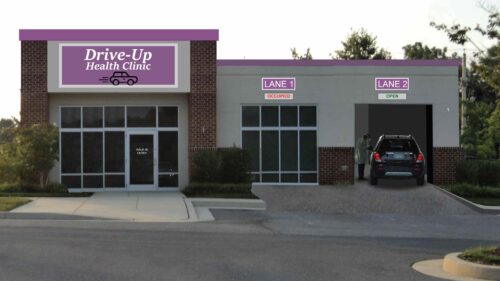
Drive-Up Healthcare
DONALD KEMP, AIA, LEED AP® BD+C, Vice PresidentFederal Studio
Transportation Studio
Change. In the healthcare industry, change is inevitable. In fact, change usually means increased benefit to patients and productivity to providers. Advances in technology have driven changes in healthcare. Enhanced precision in instrumentation and diagnostics has improved outcomes of medical procedures. Most are welcome advances patients want and providers prefer to increase success rates. Sometimes progress outpaces our willingness to accept change.
Virtual-care technology has been in existence for years; however, reluctance and limitations related to reimbursement, liability, and HIPAA requirements have stifled its acceptance. The pandemic created a greater need for managed care in a more controlled environment – limiting exposure to infection. Out of necessity, virtual care was accepted by a broader audience. But the need for in-person care persists. Access to and through medical buildings presented a major challenge. Drive-up testing sites and mobile assessments for sick patients became a viable solution.
The modern healthcare facility must limit exposure to existing and future illnesses at all phases of treatment to protect medical staff and patients. Various responses were developed to adapt existing conditions to allow patient visits and necessary treatment to occur. Additionally, efficient planning and execution allowed for increased time management and volume of patients served.
Rather than bringing patients into the buildings, some providers delivered testing, consultation, and treatment curbside. Where possible, this option was intended as a temporary solution. However, they showed promise as a long-term alternative to the traditional model for certain patient groups and services. To make these new drive-up locations more desirable and beneficial, focus on overcoming specific challenges was necessary. Weather protection, lack of supply storage, clear definition of queuing and access control, and record and payment management were some of the issues needing detailed solutions. Tenting, portable storage units, telephone and internet check-in and instructions, and site signage were solutions applied to increase efficiency. The resulting benefits included increased numbers of patients seen, isolation of infectious patients, reduction in need for post-visit sanitation of office space, less stress/more comfort for patients reluctant to interact with others (children, elderly, special needs). Vehicles became personal waiting rooms, mobile exam rooms, and essentially a one-stop shop for their healthcare needs.
Could this “temporary” condition be implemented long term? Already we are seeing this solution incorporated into design concepts as a piece of the overall design for the healthcare facility of the future, but we believe it has merit as a stand-alone option as well. First, let us examine some services* that could be diverted to the drive-up facility:
- Testing: Flu, cholesterol, diabetes, thyroid, blood draws.
- Vaccinations/Immunizations: Flu shots, allergy treatments, school immunizations, tetanus, shingles/chicken pox, and so on.
- Pediatric/Geriatric: Sick visits, routine/non-diagnostic visits, prescription renewals.
- Screening prior to facility entry.
*Each practice will have to determine if these services or any others apply and to what degree before deciding to go forward with this solution.
No matter how the drive-up option is implemented, they all share the same demands and challenges:
- Easy to use scheduling and registration (on-line, telephone, drive-up kiosk, etc.). These same options can be used for check-in purposes.
- A highly visible site would be preferable, but easy access in and out is necessary. Clear signage marking drive-up lanes and queuing, locations for waiting spaces, and parking areas if walk-up service is necessary.
- Protection from the elements in a comfort-controlled environment.
- Sufficient storage for supplies, medical instruments, PPE, etc., as required based on practice needs.
- Ample space for providers to easily gain access to patients and provide necessary services.
- ICRA required features (sinks, sanitizing stations, ventilation requirements, filters, etc.).
- Space for processing samples with proper equipment and storage.
- Biohazard waste areas.
- Administration and data input stations for EMR recording.
- Optional spaces could include labs, pharmacies, consulting rooms.
We have seen that both patients and staff are inclined to change how they perceive the patient/provider dynamic throughout this pandemic. So, this may be the time to implement changes to move healthcare delivery into the future.
In fact, a well-thought-out permanent solution should produce even greater benefits. These facilities can be smaller, therefore needing less real estate. They can be closer to main traffic arteries making them more easily accessible. Prototype designs would make them easily repeatable and quickly implemented where desired. Branding should be incorporated into the design providing instant recognition. The intent of the drive-up bays would be more generic, so various practitioners can be scheduled to use them to maximize their use.
A stand-alone facility for less intensive purposes will relieve pressure on the typical office making scheduling there easier, potentially reducing the space requirements in those offices, and increasing the quality of time spent on in-office visits.
Change. Drive-up healthcare represents positive change for patients and providers. Inevitable. Recent trends have made changes in service delivery necessary. Accepting. Circumstances have generated momentum for accepting change, so let us take advantage of it and convert this idea into a concrete option for regular service delivery. Next, we will show concepts that integrate the ideas presented here as a starting point for further development.